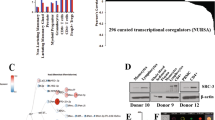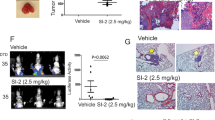Abstract
Steroid receptor coactivator-3 (SRC-3) is a multifunctional protein that plays an important role in mammary gland growth, development, and tumorigenesis. In this study, SCR-3 gene knockout mice were used to study the effects of SCR-3 on the immunosuppression accompanied with systemic inflammatory response syndrome (SIRS). Bacterial clearance assay was performed by blood culture and frozen sections, and the results showed that the absence of SCR-3 protein serious damaged the innate immune system and the body’s ability to inactivate or phagocytosis of bacteria was significantly decreased, and the absence of SCR-3 protein also weakened phagocytes’ ability to degrade bacteria and their metabolites. Furthermore, animal model of inflammatory reaction was established and the immune function was determined, and the results revealed that SRC-3 protein may play an important role in maintenance of T-cells’ immune function, and severe T-cell immune function disorder would be resulted once SRC-3 protein is missing. In addition, the results of our study showed the steady-state of lymphocyte subsets was destroyed after SIRS, leading the suppression of cellular immune function, and the absence of SCR-3 protein may aggravate the suppression of T-lymphocyte function. Therefore, the present study demonstrated that the absence of SCR-3 protein would aggravate immunosuppression. In addition, SRC-3 protein is a significant regulator of infection and inflammation, and SRC-3 protein play an essential role in the development of immunosuppression accompanied with SIRS.



Similar content being viewed by others
References
Bone RC, Balk RA, Cerra FB, Dellinger RP, Fein AM, Knaus WA et al (1992) Definitions for sepsis and organ failure and guidelines for the use of innovative therapies in sepsis. The ACCP/SCCM Consensus Conference Committee. American College of Chest Physicians/Society of Critical Care Medicine. Chest 101:1644–1655
Dinarello CA, Gelfand JA, Wolff SM (1993) Anticyto-kine strategies in the treatment of the systemic inflammatory response syndrome. JAMA 269:1829–1835
Baue AE, Durham R, Faist E (1998) Systemic inflammatory response syndrome (SIRS), multiple organ dysfunction syndromes (MODS), multiple organ failure (MOF): are we winning the battle? Shock 10:79–89
Baue AE (1999) Sepsis, multi-organ dysfunction syndrome (MODS) and multiple organ failure (MOF). Prevention is better than treatment. Minerva Anestesiol 65:477–480
Li J, Shi Z, Su YP, LOU Shu F, Liu DH, Liu XH et al (2002) Changes of serum corticosterone and hepatic glucocorticoid receptor in burned mice. Acta Acad Med Mil Tert 24:1427–1429
Schwatz HJ, Lowell FC, Melby JC (1968) Steroid resistance in bronchial asthma. Ann Intern Med 69:493–499
Smoak KA, Cidlowski JA (2004) Mechanisms of glucocorticoid receptor signaling during inflammation. Mech Ageing Dev 125:697–706
Muller M, Renkawitz R (1991) The glucocorticoid receptor. Biochem Biophy Acta 1088:171–182
Bamberger CM, Bamberger AM, de Castro M, Chrousos GP (1995) Glucocorticoid receptor beta, a potential endogenous inhibitor of glucocorticoid action in humans. J Clin Invest 95:2435–2441
Lewis Tuffin LJ, Cidlowski JA (2006) The physiology of human glucocorticoid receptor beta (hGRbeta) and glucocorticoid resistance. Ann N Y Acad Sci 1069:1–9
Webster JC, Oakley RH, Jewell CM, Cidlowski JA (2001) Proinflammatory cytokines regulate human glucocorticoid receptor gene expression and lead to the accumulation of the dominant negative beta isoform: a mechanism for the generation of glucocorticoid resistance. Proc Natl Acad Sci USA 98:6865–6870
Goecke A, Guerrero J (2006) Glucocorticoid receptor beta in acute and chronic inflammatory conditions: clinical implications. Immunobiology 211:85–96
Liao L, Kuang SQ, Yuan YH, Gonzalez SM, O’Malley BW, Xu JM (2003) Molecular structure and biological function of the cancer-amplified nuclear receptor coactivator SRC-3/AIB1. J Steroid Biochem Molr Biol 83:3–14
Giffin W, Kwast Welfeld J, Rodda DJ, Préfontaine GG, Traykova-Andonova M, Zhang Y et al (1997) Sequence-specific DNA binding and transcription factor phosphorylation by Ku Autoantigen/DNA-dependent protein kinase. Phosphorylation of Ser-527 of the rat glucocorticoid receptor. J Biol Chem 272:5647–5658
Burnstein KL, Jewell CM, Cidlowski JA (1990) Human glucocorticoid receptor cDNA contains sequences sufficient for receptor down-regulation. J Biol Chem 265:7284–7291
Kurihara I, Shibata H, Suzuki T, Ando T, Kobayashi S, Hayashi M et al (2000) Transcriptional regulation of steroid receptor coactivator-1 (SRC-1) in glucocorticoid action. Endocr Res 26:1033–1038
Du ZY, Su YP (2005) Breeding, reproducing, and identifying SRC-3 knock-out mice. Acta Acad Med Mil Tert 2005(27):373–375
Dorella FA, Estevama EM, Cardoso PG, Savassi BM, Oliveira SC, Azevedo V et al (2006) An improved protocol for electrotransformation of Corynebacterium pseudotuberculosis. Vet Microbiol 114:298–303
Singh SK, Banerjee PC (2006) High-yielding plasmid extraction method from acidophilic heterotrophic bacteria of the genus Acidiphilium. Anal Biochem 356:229–234
Xu JM, Liao L, Ning G, Hiromi YK, Deng CX, O’Malley BW (2000) The steroid receptor coactivator SRC-3 (p/CIP/RAC3/AIB1/ACTR/TRAM-1) is required for normal growth, puberty, female reproductive function, and mammary gland development. Proc Natl Acad Sci USA 97:6379–6384
Borregaard N, Elsbach P, Ganz T, Garred P, Svejgaard A (2000) Innate immunity: from plants to humans. Immunol Today 21:68–70
Takeda K, Akira S (2005) Toll-like receptors in innate immunity. Int Immunol 17:1–14
Montero Vega MT, de Andrés Martín A (2008) Toll-like receptors: a family of innate sensors of danger that alert and drive immunity. Allergol Immunopathol 36:347–357
Turvey SE, Broide DH (2010) Innate immunity. J Allergy Clin Immun 125:s24–s32
Coelho AL, Hogaboam CM, Kunkel SL (2005) Chemokines provide the sustained inflammatory bridge between innate and acquired immunity. Cytokine Growth Factor Rev 16:553–560
Alfano M, Poli G (2005) Role of cytokines and chemokines in the regulation of innate immunity and HIV infection. Mol Immunol 42:161–182
Walz CR, Zedler S, Schneider CP, Mayr S, Loehe F, Bruns CJ et al (2007) Depressed T cell-derived IFN-gamma following trauma-hemorrhage: a potential mechanism for diminished APC responses. Langenbecks Arch Surg 392:339–343
Nelson DL, Warner C (1996) The human interleukin 2 receptor: normal and abnormal expression in T cells and retroviruses. Ann Int Med 105:560–563
Zhan JH, Mao YG, Zhang HY, Zeng YL, Li GH (2004) A study on the cellular immune function in severely burned patients. J Chin Microcirc 8:48–50
Pellegrini JD, De AK, Kodys K, Puyana JC, Furse RK, Miller-Graziano C (2000) Relationships between T lymphocyte apoptosis and anergy following trauma. J Surg Res 88:200–206
Montoya MC, Sancho D, Vicente Manzanares M, Sánchez-Madrid F (2002) Cell adhesion and polarity during immune interactions. Immunol Rev 186:68–82
Acknowledgments
This work was supported by State Key Laboratory Open Foundation of Trauma, Burns, and Combined Injury (No. SKLKF200910) and China Postdoctoral Science Foundation (No. 20100471764).
Author information
Authors and Affiliations
Corresponding authors
Rights and permissions
About this article
Cite this article
Li, J., Niu, J., Ou, S. et al. Effects of SCR-3 on the immunosuppression accompanied with the systemic inflammatory response syndrome. Mol Cell Biochem 364, 29–37 (2012). https://doi.org/10.1007/s11010-011-1201-y
Received:
Accepted:
Published:
Issue Date:
DOI: https://doi.org/10.1007/s11010-011-1201-y




